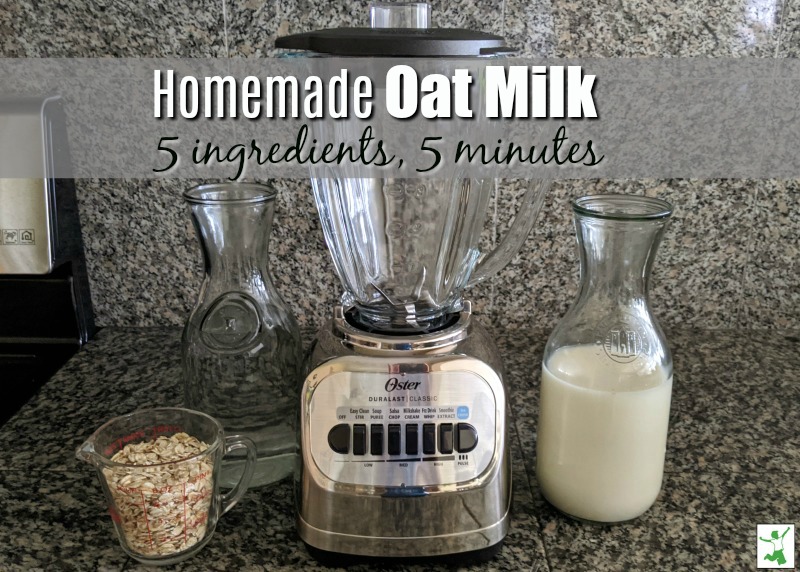
Oat milk has a couple of big things going for it as a milk substitute. First of all, it is very mild in flavor and hence, the best tasting (in my opinion), alternative to dairy in lattes and other dishes.
Secondly, it tastes mildly sweet without any additional sugar.
These two reasons are why I believe the demand for oat milk is off the charts recently both at coffee shops and at the store. This stuff seems to be everywhere!
Commercial Oat Milk Dangers
Before you run out and buy a carton, however, note that there are two big negative reasons against consuming commercial oat milk.
First and foremost, it is off the charts high in phytates because raw oats are naturally very high in this anti-nutrient.
Of course, food corporations generally don’t recognize this fact let alone do anything about it during the manufacturing process. They simply make it, market it slickly and aggressively, and report awesome earnings quarter after quarter to their shareholders.
Toxic Packaging
Secondly, manufacturers flash pasteurize oat milk before packaging. This means boiling hot liquid is poured into the container at the time the package is sealed to sterilize it.
Most people don’t realize that cartons have a thin layer of plastic lining the inside. So, tetra-paks are no better than plastic bottles. Both packaging methods involve very hot liquid contacting plastic for many minutes until the liquid cools down inside the container.
Leaching of hormone-disrupting toxins into the oat milk absolutely occurs as a result of this process no matter what type of plastic the manufacturer uses.
This same problem plagues nearly all store-bought milk alternatives, by the way.
Only a few brands actually care enough about their customers to cool down the liquid and bottle at a safe temperature to ensure their products are non-toxic (such as this one).
Ultimately, it’s up to you to educate yourself not just about ingredients but also processing and packaging. For example, the ingredients of several oat milk brands I checked looked fine on the surface. But, they absolutely go on the “never buy” list when you factor in manufacturing and packaging methods.
Knowing about the high level of phytates combined with the toxic packaging signals “do not buy” to the savvy consumers.
My Experience Drinking Store Oat Milk
When I decided to figure out a way to make homemade oat milk for those of you who enjoy it and really need to use it because of a true dairy allergy (not a pasteurization allergy), I realized I needed to (ugh) try the commercial stuff to see how it smelled, tasted, etc.
So, I bought what was the best brand I could find out there. And, I have to tell you, I got an almost immediate (as in, within 5 minutes) stomach ache from consuming a small glass!
This happened every single time I tried it whether alone as an ingredient in one of my homemade lattes.
The lattes tasted fine, but I was nearly doubled over with stomach cramps from the antinutrients in the oat milk.
I have pretty much an iron stomach too. So for something to cause me tummy pain, it’s got to be virtually indigestible.
To those who say, “I drink store oat milk all the time with no problems”, I would suggest that your stomach may be so beaten up that it isn’t even sending pain signals to your brain anymore.
DIY Oat Milk (all the benefits, none of the downside)
The great news is that homemade oat milk is a cinch to make. The trick is to use sprouted rolled oats instead of regular rolled oats used by food manufacturers for the commercial stuff.
Sprouted oats have little to no phytic acid as the sprouting process neutralizes them.
Soaking rolled oats overnight like the recipe for oat water in the Nourishing Traditions cookbook, unfortunately, results in slimy oat milk.
Of course, sprouted oats can’t be eaten raw … they need to be cooked thoroughly first. But, the oat milk-making process removes all the hard to digest residue leaving just the oat “milk” behind.
Drinking sprouted oat milk didn’t give me any digestive upset whatsoever!
You will notice that sprouted oat milk is a bit lighter in color compared to commercial brands. It also tastes more oat-y for lack of a better word…this is a good thing! In other words, it is fresher tasting than store-bought.
Try it as a milk substitute in your favorite dairy-free recipes!
I hope you enjoy it 🙂
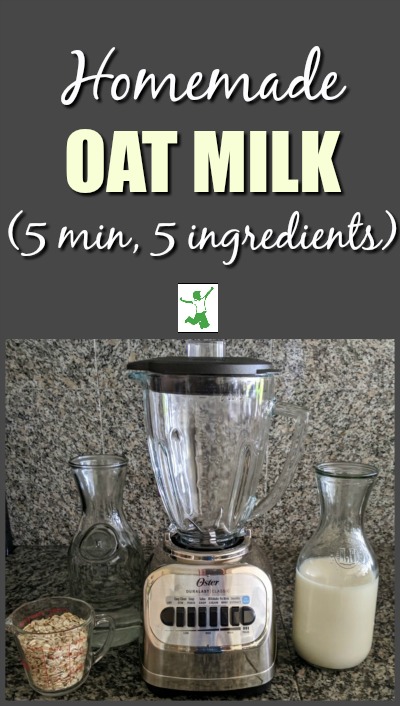
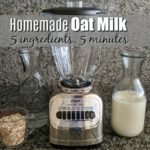
Homemade Oat Milk
Homemade sprouted oat milk that is easy to digest and more nourishing than brands from the store. Quick to make in five minutes with only five ingredients!
Ingredients
- 1 quart filtered water
- 1 cup sprouted rolled oats
- 1 scoop collagen peptides
- 2 Tbl avocado oil
- 1 smidgen sea salt
Instructions
-
Add water and sprouted rolled oats to a blender.
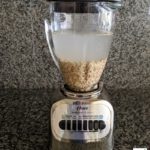
-
Blend on high for 30 seconds.
-
Strain liquid into a bowl through a clean white flour sack cloth or dishtowel. Toss or compost sieved oat fragments.
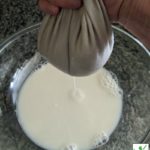
-
Stir in oil and peptides into the filtered oat milk until mixed well.
-
Pour into a glass container and refrigerate. Homemade oat milk lasts about 5 days.
-
Blend well before serving for best taste and consistency.
Recipe Video
Recipe Notes
Do not use steel cut oats or oat groats for this recipe. Rolled oats definitely produce the best results.
Do not blend for more than about 30-45 seconds or the oat milk turns out a bit slimy.
A smidgen is 1/2 pinch or 1/32 of a teaspoon.








Thank you for this recipe! I’ll be trying it tonight. I’m wondering if there is any use for the finely ground oats besides tossing them?
Do you have to add the oil or could you just add a scoop of pureed sunflower seeds so it is not a processed oil? I buy organic sprouted oats through Costco so are those Ok? Thanks in advance!
I would suggest using unrefined sunflower oil instead of pureed sunflower seeds as that would alter the smooth texture of the oat milk.
I was curious about your statement you made regarding not being able to eat raw sprouted oats. Are the oats you are using not raw sprouted oats? I do not see anything involving cooking them. ty
You don’t need to cook the sprouted oats when making oat milk … you are removing the undigestible parts via the straining process.
When making homemade oat milk do you think we should worry about bacteria because it is non-pasteurized? Do you rinse your oats before hand to clean them, is that even necessary? I’ve been making oat milk for three weeks now but wondering if I need to take these extra steps.
The fermenting of the oat milk wouldn’t work if there were pathogenic bacteria in the mix.
Thank you for this recipe! While I agree with the idea of using sprouted oats, I’m avoiding plastic packaged products (unless the brand you mention is wrapped in paper, but I think it’s in a plastic package.) Going zero waste really limits what ingredients I can use :-/
I’ve been making my own oat milk, and I honestly don’t mind the sliminess….would you have a suggestion as to how to make it properly with regular rolled oats (unsprouted)?
The way I’m making it now, I soak it overnight, but I use the same soaking water for the milk. Should I be discarding the soaking water and adding new water for the milk?
Thank you!
Hello. How long am I supposed to mix the avocado oil and collagen? The oil is kinda going to the top, what’s the purpose of the oil anyway? Thanks! 🙂
The purpose of the oil is to add some healthy fatty acids so that it balances out the macros to more closely resemble actual milk.
The oil will always come to the top which is why you should mix it each time you intend to use some. Note that the brands at the store have oil added as well and you are instructed to shake the container before pouring.
Hi Sarah,
Really enjoy your articles. I’m a real newly. How do you sprout oats? How long does it take?
What do they look like? Do you dump them in or do something to them first? Thanks.
Here’s my recipe plus videos on how to sprout grains. https://www.thehealthyhomeeconomist.com/video-thursday-sprouting-flour/ You would use groats in this case.
However, I would not recommend sprouting groats as it would be very time intensive. If you want an even less expensive homemade oat milk, soak the groats first and then flake them. https://www.thehealthyhomeeconomist.com/soaked-oat-milk/
Looking forward to trying it. Note that Tetra Pak packages for these kind of products (and all liquid products in fact) are filled at room temperature. There are no boiling hot liquids in contact with the packaging material. The heating is done before filling. The product is cooled and stored aseptically before being filled and sealed. The process you describe might apply better to canned products, products in glass jars and some products that are hot-filled i.e.: high acid juices etc.
I’ve checked with tetra-pak manufacturers and the liquid is very hot when the tetra-paks are sealed. This is to ensure that the product is sterilized and free of bacteria.
Hello,
Thank you for this great article. I use oat milk due to a nut and dairy allergy and had no idea about the dangers with commercial oat milk. I would love to try your recipe to make my own. What is the role of the role of the collagen peptides and is there a vegan or vegetarian alternative? I have Alpha Gal allergy and cannot consume beef in any form.
Thank you for this helpful information.
You can leave out the collagen if you like … it simply adds protein as oat milk is very low in this macro.
That’s a good idea Sarah. Unfortunately I can’t access sprouted oats in Hong Kong (where I live). You think I can just soak the rolled oats overnight to reduce the phytate acid? Is it necessary to add an acidic liquid? I don’t want sour oat milk…..
Unfortunately, soaking rolled oats doesn’t work for homemade oat milk as it turns out very slimy. Using sprouted rolled oats is the only way it works that I’ve tried.
The other way you could do it but it would be time intensive is to sprout or soak oat groats, dehydrate them and then make rolled oats yourself with the flaker attachment for a grain mill. https://amzn.to/393JA1Q